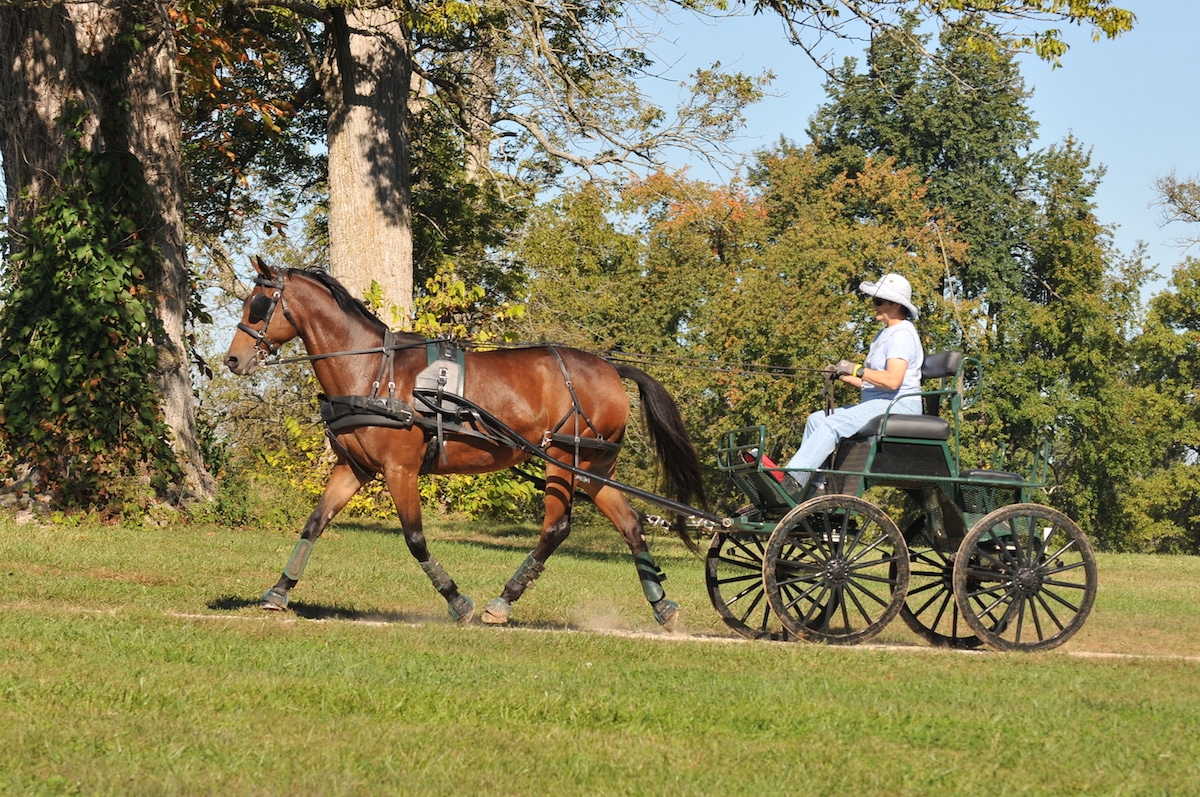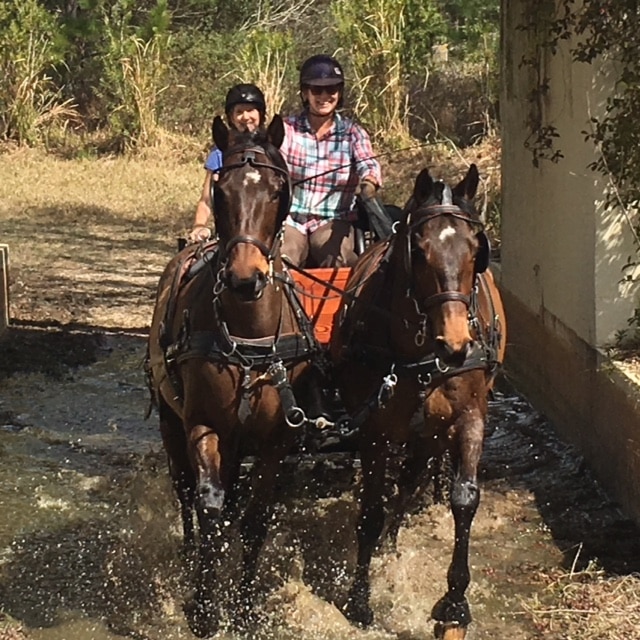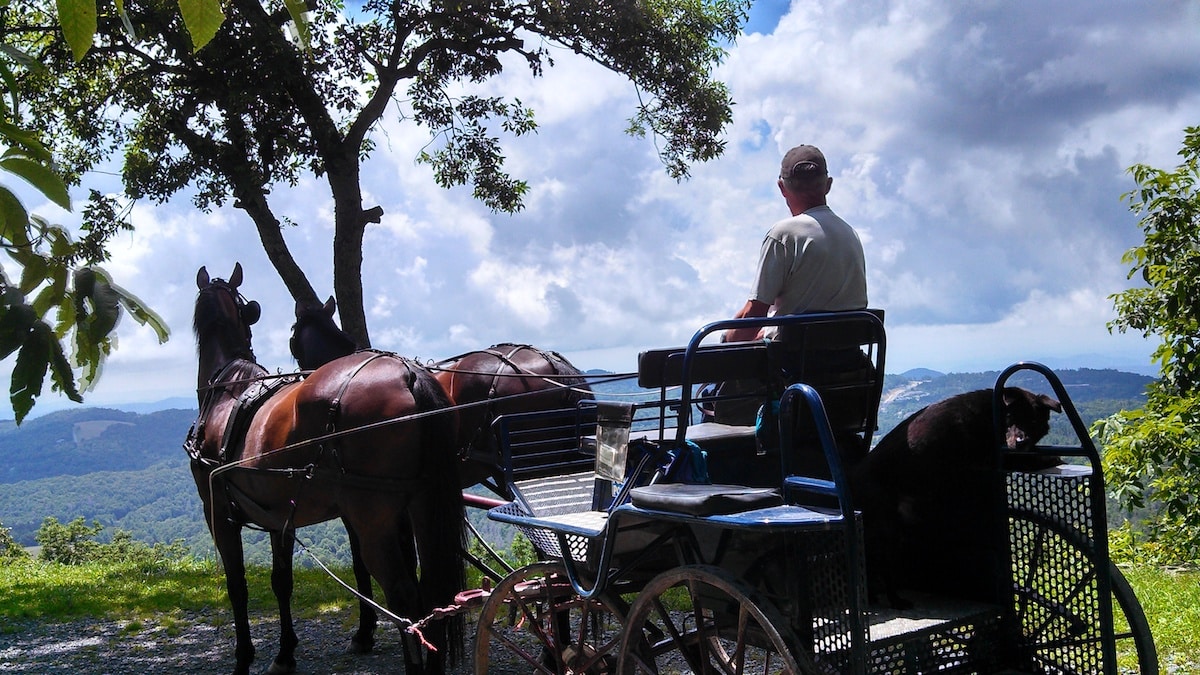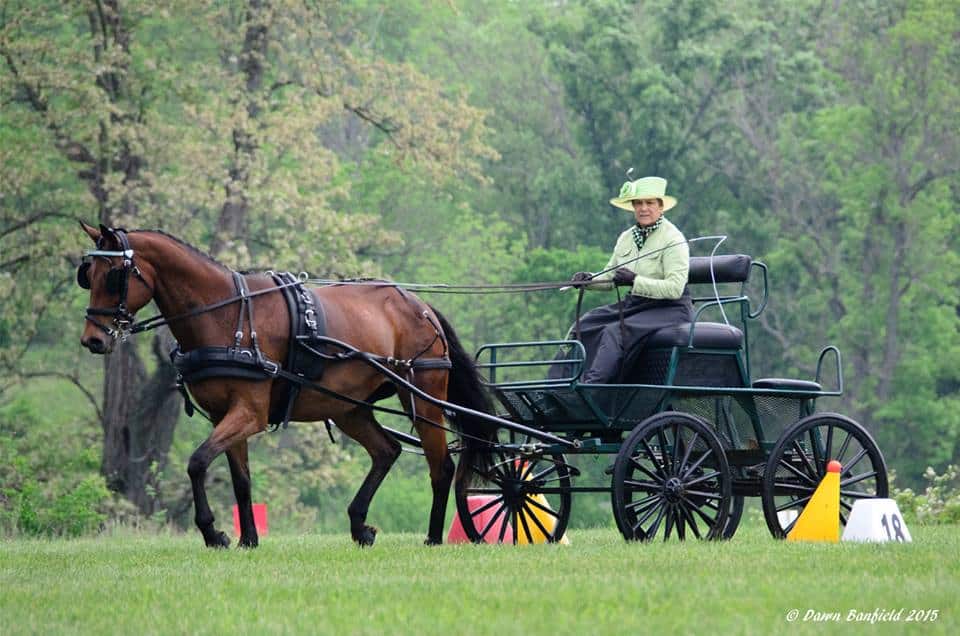Ex-racehorses excelling in harness rather than under saddle.

Nancy Dozier and her OTTB Go Go Susie participate in the 2013 National Drive, in Lexington, Kentucky. Dawn Banfield Photo, Courtesy Nancy Dozier
At first Stacey Giere kept the breed of her combined driving horse a secret. But one day in 2012 at the Kentucky Horse Park, in Lexington, she saw a golf cart labeled “Thoroughbred Horse Show,” and decided to fess up.
Jan Roehl, founder of the Thoroughbred Horse Show Association, was driving the golf cart and recalls the meeting. “She says, ‘Hey, I’m Stacey, and I don’t tell anyone, but the horse I drive is a Thoroughbred.’ ”
Roehl had been looking for someone to train her own Thoroughbred to drive with little success, as no one in the industry up to that point had been willing to work with Prayer Service (Stephen Got Even — Real Bad Girl, by Housebuster), a five-time winner at Oaklawn, Ellis Park and Churchill Downs in his five-year racing career. But fate introduced Roehl and Giere that weekend at the Horse Park when a Thoroughbred Horse Show Association competition and a combined driving event took place simultaneously.
“I said, ‘Is there any chance you’d want to train my Thoroughbred to drive?’ ” Roehl says. “(Giere) was up in Ohio, and I sent (Prayer Service) up to her the next week. He spent the winter in training, I got him back in March and we competed in May.
“It took me two years to find a trainer who would teach him to carriage drive,” she adds, noting that Giere said Prayer Service was the easiest horse to train.
One has to look no further than the popular Budweiser Clydesdales captivating Super Bowl commercial viewers or the robust Dutch Warmbloods leading the carriages of 14-time U.S. Equestrian Four-in-Hand National Champion Chester Weber to understand that Thoroughbreds are not your stereotypical carriage-driving horses. But Roehl, along with several others, has come to discover the doors that driving opens for racehorses seeking a fresh start, particularly for “War Horses” or those that might have nagging injuries from their racing careers.
“It’s a lot easier on them,” Roehl says. “They don’t carry any weight on their backs. Life is at the walk and trot, and they learn to do a lot of standing.”
Prayer Service became Roehl’s first spokes-horse for OTTBs as driving prospects. The bay earned more than $160,000 from 28 starts on the racetrack, but when his first career concluded in 2008, he had trouble finding a home due his cribbing and his weak tendons. Roehl, who had stepped away from competitive eventing, wanted to learn to carriage drive and decided Prayer Service would be the ideal partner.
“He was (with Giere) for 90 days, he came home and was already broke to a carriage and had a vocabulary of eight or 10 words,” says Roehl. “He now has a vocabulary of 14 to 16 words; the maximum they ever need to learn is 20.”
Prayer Service took to the discipline so quickly that Roehl began setting her sights on loftier goals. She adopted Look ah Yondah (Distant View — Caique, by Quest For Fame) from the Thoroughbred rehabilitation and retraining organization CANTER Kentucky to add to her string.
“It was my biggest dream to have a pair,” Roehl says.
Yondah has six screws in his right front ankle due to a condylar fracture suffered on the track, but that didn’t stop him from becoming a successful driving horse. He and “Prayer” have participated in the National Drive at the Horse Park, the world’s largest gathering of carriage drivers, and competed at the preliminary level in combined driving, which consists of three phases: driving dressage, marathon and cones.
Roehl, who works for Keeneland as a clocker and at the Thoroughbred sales, is also in the process of building a layup and rehabilitation facility for Thoroughbreds in need of stall rest — called The Horse Lodge — and hopes to train another OTTB to carriage drive at a future Retired Racehorse Project Thoroughbred Makeover. After spending decades galloping both on the track and across the cross-country field, the 59-year-old says her Thoroughbreds aren’t the only ones who have benefited from their new discipline.
“It’s a way to hang out with the horses, and it doesn’t tear your body up,” she says. “Driving takes more time, but it doesn’t wear you out. It’s not physically demanding on my body anymore. I’m spending more time training than I ever have before.”

Jan Roehl achieved her dream of having a driving pair with Thoroughbreds Prayer Service and Look ah Yondah. Courtesy Jan Roehl
Matching Up
Roehl got to know another Thoroughbred driver at the National Drive. In 2014 she connected with Lyle Peterson, whose own carriage was pulled by a Thoroughbred, and the two devised a plan to join their pairs at Riverplains Farm, in Strawberry Plains, Tennessee.
Peterson, of Mars Hill, North Carolina, had been driving for more than a decade when he was introduced to his first Thoroughbred in 1993. At the time, he had worked primarily with Arabians and was seeking a better physical match for one of his Warmblood fillies.
“I was walking one day, and across the road there was an old Thoroughbred racing stable,” Peterson recalls. “There was a mare in the paddock that looked like she’d match one of the fillies I was driving, so I went to stable and asked about her. She was not for sale, but they said they had a gelding that was going to auction that Friday if he didn’t get sold before then. They had him basically priced at meat price.”
Peterson took the gelding with the idea that if he didn’t work out as a driving horse, he could resell him as a pleasure horse, but the 3-year-old Possum Holler (Peacebreaker — Sasa Fefe, by Ribet), better known as “Jones,” had no interest in letting down the man who rescued him. The bay quickly displayed an affinity for driving and, paired with a Quarter Horse mare, competed up to the preliminary level in combined driving across the country, even winning in Strawberry Plains. Jones and Peterson were partnered for 16 years until Jones died at 19 in 2009.
“I rode him and drove him many, many, many miles,” Peterson says.
Jones spent the final seven years of his life paired with a second Thoroughbred — called, simply, “Smith” — whom Peterson acquired off the track through a local veterinarian’s recommendation.
“The two of them didn’t match in any way, but they worked great together,” Peterson says. “I drove those two Thoroughbred geldings for seven years. I don’t claim fantastic competitive success for them, but they just looked great together.”
Smith’s next partner after Jones was another retired racehorse, just of a different breed. The Standardbred Mars Man, or “Wes,” joined Peterson, Roehl and their Thoroughbreds for a four-in-hand training session in 2015.
“That was such a thrill,” says Peterson. “Three Thoroughbreds and a Standardbred, ex-racehorses all!”

Lyle Peterson drove a pair of ex-racers — a Thoroughbred and a Standardbred — named Smith and Wes. Courtesy Lyle Peterson
On a Whim
Nancy Dozier acts on feeling. She got into carriage driving when she, on a whim, bought a Clydesdale as a Christmas present to herself, and it was another somewhat impulsive decision that led the Walbesh, Indiana, native to buying a Thoroughbred.
Go Go Susie, a daughter of Polish Navy, never made it to the races, and from there had a go at barrel racing with a junior rider. It was career No. 3 that stuck.
“We just bonded from the first time I saw her,” says Dozier, who found out about the mare through farrier Jay Smiley and purchased her privately from the family who had acquired her off the track. “When I saw this horse, I just fell in love with her. She’s a pretty mahogany bay with black points, and it was just her attitude. She was just a pasture horse for a while. I rode her from time to time and tried to figure out what I would do with her.”
She settled on combined driving and sent “Susie” to Leroy Hirschberger, in Rushville, Indiana, for training.
“The second time (I went to visit), he had her hitched to a cart, and he took me for a ride,” Dozier says. “Susie loved it. He had already taken her on the road. He said he’d never taught a Thoroughbred to (drive) before, but he thought she was a really nice little horse.”
It wasn’t long before Susie was competing in combined driving events (CDEs) around the tri-state. While Dozier notes that dressage proved difficult for Susie, the mare’s Thoroughbred blood and stamina helped her excel in the marathon phase, which is about 6 miles long and includes various obstacles, including water hazards, steep hills, sharp turns and mazes. Before the marathon course begins, competitors drive through a series of roads and tracks and have a 10-minute rest period, a walk section and a vet check.
“She never had time penalties,” Dozier says. “That competitiveness is what makes her stand out. (During the vet check, the veterinarians) would see the mare and say, ‘What are you even doing to this horse? She’s not breathing hard. What breed is this horse?’ ”
To which she’d proudly reply: “She’s a Thoroughbred.”

Go Go Susie found a third career that stuck with Nancy Dozier, seen here competing at the 2015 Gayla CDE in Georgetown, Kentucky. Dawn Banfield Photo, Courtesy Nancy Dozier
Learning the Ropes
While Thoroughbred racehorses might not seem predisposed to be successful driving horses, a lot of training they receive on the track does, in fact, set them ahead for a second career in the sport.
“The most important thing about carriage driving is that a horse will stand still,” says Jan Roehl, a carriage driver based in Kentucky. “Some horses are inclined to stand still, and some are not, but racehorses get a lot of stand-still training, especially in the (starting) gate. If the horse is willing to stand still, everything else is pretty simple.”
When horses are trained to drive, one of the biggest elements is learning to accept a carriage. Thoroughbreds are not typically scared of the carriage shafts because they’re used to traffic and commotion in the gate, says Roehl.
They must also learn to understand the discipline’s voice commands, getting used to verbal cues that come from behind their haunches rather than from a rider just behind their ears.
“With Jones, I took him up to my arena the first day I had him, and I put some long lines on him, and I put the harness on him one piece at a time,” says Lyle Peterson of working with his first Thoroughbred on his farm in Tennessee. “I put the crupper (a piece of tack that keeps the harness from sliding forward) on him; then I put on the collar. I’ll often put a couple of PVC poles through the cutlets to simulate the shafts on a cart so they get used to … having something bump their thighs and legs, and I’ll deliberately take them around in circles and serpentines.”
Peterson gradually added pieces of equipment until the carriage was completely assembled and hitched.
“He started pulling some weight, and he just went ahead and did it,” he says. “I hooked up the cart and drove him from the ground for a little while, and he was just fine. Then I got in the cart and drove around a couple times more. I opened gate and drove him to the farm (from where I purchased him), and said (to his previous owner), ‘I think this is going to work out OK.’ The whole process took about 45 minutes.”
A driving horse typically begins with a vocabulary of eight to 10 words. Horses competing at the advanced level — the levels are training, preliminary, intermediate and advanced — have a vocabulary of 20 words. Unsurprisingly, the first word to enter the vocabulary is “standing.”
“‘Walk on’ is another one,” says Roehl, “as is, ‘step in,’ to have them step sideways into the carriage. ‘Step back’ is another big one. After that, for cones and hazards, you teach them ‘getting in,’ which means going in between objects. It directs a pair to come together and surge forward.”
“If you work them pretty steadily for a month or so, after that it’s just refinement,” Peterson says.
This article was originally published in the Winter 2018 issue of Off-Track Thoroughbred Magazine, the only publication dedicated to the Thoroughbred ex-racehorse in second careers. Want four information-packed issues a year delivered to your door or your favorite digital device? Subscribe now!

